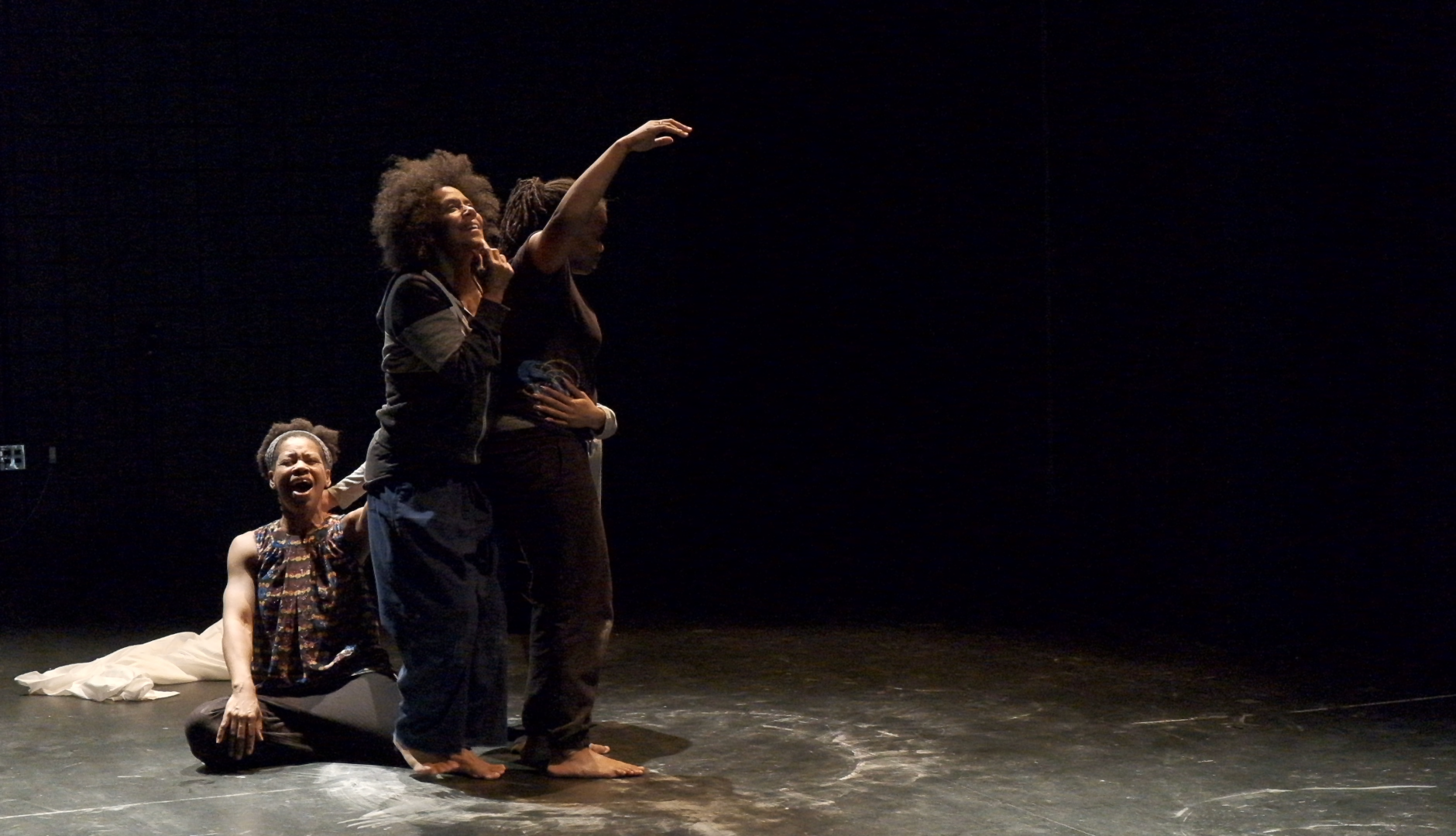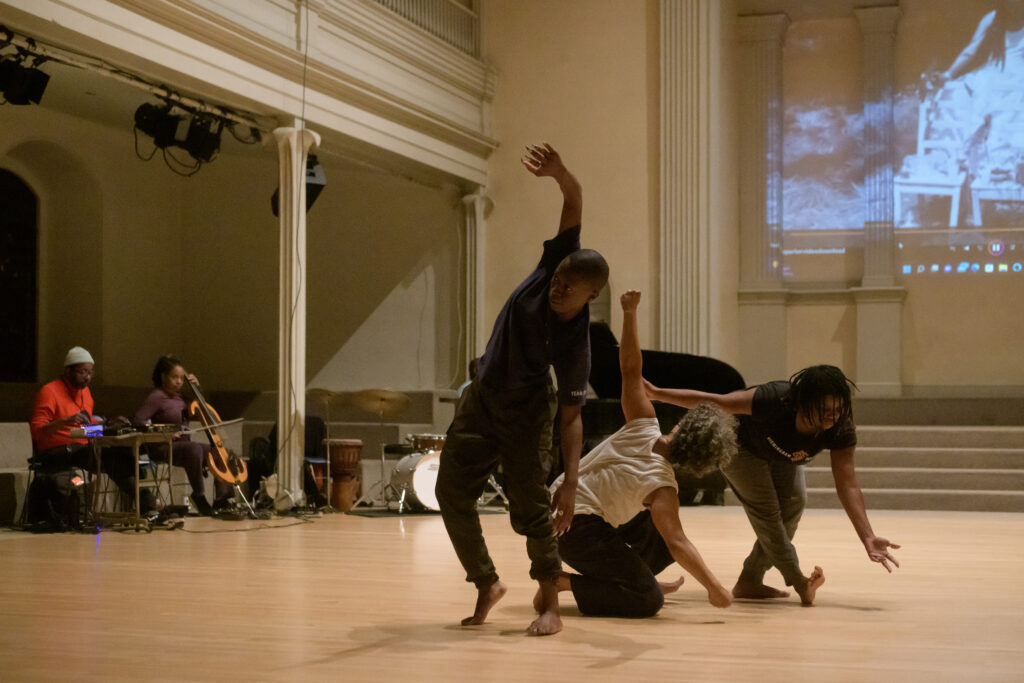Call to Remember Methodologies: Reflections
On methods for conjuring Black Space and dance improvisation as a way to access collective memory and ancestral wisdom

In 2020, Leslie Parker Dance Project (LPDP) embarked on Call to Remember (CtR), a multi-year offering of improvisation, experimentation, and conjuring through the exploration of Black pedagogy, artistry, and activism in dance. CtR’s work affirms improvisation as a critical dance form with specific cultural relevance for Black and Brown bodies.
In drawing together different improvisations and experimentations, CtR conjures Black Space—a liberated, creative space that generates solidarity among interconnected lineages of artists, writers, and scholars, who hold multiple perspectives but have each contributed to the discourse of Black art. Parker—dancer, founder, initiator, and director of LPDP—shares this framing: “I define Black Space as a form of consciousness not limited to or bound by place, time, energy, or geographic location. It is, and can be shared as a way of thinking/being in time. Black Space is neither exclusive nor is it inclusive to any one person, people, place or thing. It exists in the unknown, the subconscious, the mystical/magical, and infinitely here and now with deep cultural roots in Black Pan-African and transatlantic African diasporic cultures and communities.”1
Call to Remember Collective Practice
A closer look at how CtR moves across differing times and stages reveals it as more than a dance project: CtR is a methodology. CtR exists as a framework of practice and being that draws together dance, creative research, archival practices, and experimentation in movement, music, storytelling, visual arts, and writing. Though improvisation is central to CtR, its larger work interweaves collective knowledge using experimentation and ancestral wisdom—ultimately harnessing knowledge through dance art of the past, present, and future.
There exist multiple perspectives on, and entry points into, collective memory. Dance, as an embodied practice, is a means to accessing such a space. In dance, the self is a site for creative research and mapping. Parker notes, “The bigger goal of this work is to move Black culture(s) into the future through dance art. Black Space is inspired by working with difference, cross-pollinating ideas, and acknowledging multiple, intersecting identities. Black Space is the site wherein dance artists collaboratively express ideas on a global platform. Collaborative relationship building is central to this work. While building bridges is key, crossing bridges is essential to genuine exchange.”2
Through the work of CtR, LPDP has brought dancers, musicians, visual artists, composers, writers, activists, organizers and art institutions together in a multi-year engagement. These connections have unfolded into community workshops, residencies, main stage performances, installations, archival research, and publications. LPDP endeavors to create more supportive environments that cultivate collaborative exchanges in dance art, and explore both the archival and living histories of Black improvisation.
Black Dance Improvisation Workshop Series, BDI, is an educational component of CtR that brings to light Black dance studies and Black improvisation from a femme lens. BDI offers a public practice open to Black, Native, Indigenous, People of Color and BIPOC allies of varied experiences in dance. Having evolved over the past five years, CtR continues to dismantle hierarchical structures that exist between dancer and choreographer, for example, to foster a more spacious container for exploration. Each dancer, musician, and artistic collaborator embodies fluidity as their roles shapeshift at any given moment. Parker is credited with being the visionary, although each collaborator contributes to the work uniquely as makers, performers, and dancers in ways needed, wanted, and inspired instinctively. The objective is to hold space within the practice of remembrance, with care, as we address or redress our individual and collective needs and wants. The specific alignments of movement, music, and attunements to spirit become manifest in this work. These practices of remembrance in turn generate CtR’s spaces of collective experimentation and innovation amongst Black and Brown peoples. These spaces are crucial because Black and Brown people have been systematically denied the space to collectively hold the depths of their/our experiences and create from this space of love, joy, grief, knowledge, and feeling. Black feminist poet and scholar Bettina Judd reminds us that feeling is so important because of how it “‘wills the work forward’ in and through the weight of needing to feel.”3
A Constellation of Lineages
CtR’s methodology is particular. Parker is intentional and exacting in the grammars of speech and movement that CtR is founded on. CtR situates itself within a particular Blackened lineage, which becomes paramount to cultivating this collective practice of remembrance. The project foregrounds the lived experiences of Black women, femmes, and nonbinary people with their histories, futures, and experimentations in dance. As a methodology, it is rooted in the critical need for Black ancestry, experiences, and perspectives to be centered. This can look like honoring ceremonial testimonies, rebuilding trust with institutions, and fostering intimacy and solidarity among Black artists. CtR endeavors to facilitate such a space as part of an international, global discourse on Black art.
While CtR is a specific embodied, somatic, and ontological frame of reference originating from LPDP, CtR acknowledges that it does not stand alone. CtR exists within a constellation of Black dance lineages and creative practices. Even as dance exists in these multiplicities, each and every person, and body, carries its own specific entry point into dance, and legacies from which it draws. CtR exists within a lineage of Black experimentalism, and deeply acknowledges the spirit of Laurie Carlos as part of a foregrounding force in this work.
In a recent taped conversation between leading practitioners of dance, Marlies Yearby, Nia Love, Leslie Parker, and Black Feminist scholar and dancer Naimah Petigny reflected on these lineages and creative practices that become sacred to Black dance. Within just a few minutes, Laurie Carlos was called into the space. Laurie Carlos (1949–2016)—ancestor, groundbreaking Black woman theater artist, and beloved Twin Cities community member/leader—was a mentor to Yearby, Love, and Parker, working closely with them throughout key moments of their careers. Having grown up in the East Village in New York City, Carlos was an Obie- and Bessie Award-winning artist well known as the original “lady in blue” in Ntozake Shange’s for colored girls who have considered suicide/when the rainbow is enuf.4 Throughout her lifetime, Carlos created numerous works of cross-genre performance from within her own, distinct theater-making practice. Her deeply autobiographical works, such as The Pork Chop Wars (a story of mothers), The Cooking Show and How the Monkey Dances, and White Chocolate for My Father, explored the contours of Black, femme, queer experience. The breath was foundational to her practice. Carlos grounded her work within Black, theatrical jazz traditions, while also innovating and breaking with convention.

Divination Tools: imagine home
Through collaborative improvisation and dance experimentation, Divination Tools: imagine home is the latest iteration of Call to Remember. The work is an exploration of Black pedagogy, conjuring, and activism, while emphasizing remembrance in order to cultivate community. Reflecting on divinity and lineage, Divination Tools: imagine home draws from Blackness in music, dance, and storytelling in real time.
Improvisation, experimentation, and conjuring are central pillars and practices in CtR’s methodology that come together in Divination Tools. With improvisation as a movement medium, experimentation an entry into and through the work, conjuring as a spiritual intention, and following ancestral traces as a way to re-remember that which we have lost—CtR offers collaborators and audiences alike a way back in. It is an embodied practice of remembrance that acknowledges ancestors and allows the body to become a conduit for divinity, all the while allowing for release and expansion. CtR holds moments to conjure freedom, protection, and love in a space where Blackness—with all of its complexities and intersecting identities—exists now and in the future.
The weekend of May 11-13, 2023 marks an exciting moment for Black dance in the Twin Cities. As mentioned above, CtR’s Divination Tools: imagine home premieres at the Walker Art Center. Running concurrently, St. Paul’s TU Dance presents The 3-Women Project, featuring work by choreographers Stefanie Batten Bland, Alanna Morris, and Yusha-Marie Sorzano. These offerings are a unique opportunity to celebrate the interconnectedness of Black dance.
Over the past three years, CtR as a methodology has advanced LPDP mission goals by creating more opportunities for rigorous artistic practice in dance; and by advocating for existing collaborating organizations and current partners to challenge hierarchies, expand resources, and redistribute resources more equitably, both inside and outside of the collaboration. As a collaborative entity, CtR facilitates all-immersive approaches to Blackness, memory, improvisation, and healing through dance. Call to Remember invites all into a global, collective practice of remembrance, ushered in through improvised soundscapes and dance, while emphasizing a type of mindfulness that moves us all into deeper connectivity.
Leslie Parker Dance Project’s Divination Tools: imagine home premieres at the Walker Art Center May 11-13, 2023. >> more information